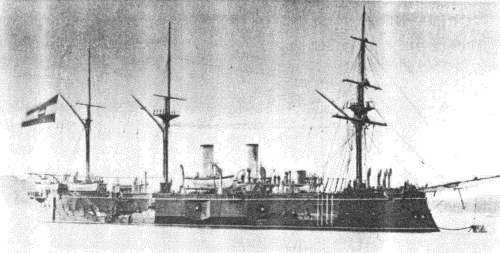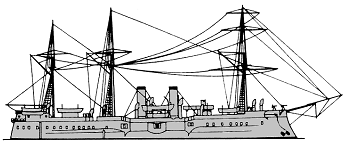
NAVYPEDIA
 Support the project with paypal
Support the project with paypal
Photo

Tegetthoff 1881 Many thanks to Wolfgang Stöhr for additional information on this page.
Ships
| Name | No | Yard No | Builder | Laid down | Launched | Comp | Fate |
|---|---|---|---|---|---|---|---|
| Tegetthoff, 1912- Mars | 127 | STT, San Rocco | 1.4.1876 | 15.10.1878 | 10/1881 | TS 1917, hulk 1918 |
Technical data
| Displacement normal, t | 7431 |
|---|---|
| Displacement full, t | |
| Length, m | 92.5 oa 89.4 wl |
| Breadth, m | 21.8 |
| Draught, m | 7.57 |
| No of shafts | 1 |
| Machinery | 1 2-cyl HRCR, 9 cylindrical boilers |
| Power, h. p. | 6706 |
| Max speed, kts | 14 |
| Fuel, t | coal 670 |
| Endurance, nm(kts) | 3000(10) |
| Armour, mm | wrought iron; belt: 370, bulkheads: 300 - 250, casemates: 370, deck: 40, CT: 175 - 125 |
| Armament | 6 x 1 - 283/20 G. L/22 C.75, 6 x 1 - 87/22 G. L/24 M.75, 2 x 1 - 66/16 G. L/18, 2 - 350 TT (1 bow, 1 stern) |
| Complement | 525 |
Standard scale images

Tegetthoff 1881
Graphics
Project history
One of the most interesting ships of her time. Von Romako's intention was to design a 'bow-battery' ship that could use its guns during pursuit and ramming. The ship's design shows a good balance between low displacement and six fully protected heavy guns. These were sited in a citadel and had overlapping arcs of fire. The heavily armoured battery was designed without overhanging sponsons to give a flush surface without projections, so the ship's artillery was in no danger of being put out of action in case of a close fight or after being rammed. The ammunition was stored directly under the guns. Another innovation was the shape of the hull about the waterline so that the armour plates had to be bent in only one direction. During a major refit she was converted to twin screws with new Schichau-built engines. The masts were removed, two heavy military masts with fighting tops were erected, and she was given modern guns.
Ship protection
The belt was extended from 1.4m under wl to 1.3m above and protected 95% of ship length (excluding 9.8m part from the stem), closing fwd by 305mm transverse bulkhead. Its thickness amidships was 368mm (tapering to 330mm at lower edge) and 330mm at aft end, backed by 254mm teak. The fwd part outside the belt was protected by 64mm turtleback form deck. Casemate armour extended from upper edge of the belt to the upper deck and protected 45% of ship length. Casemate had 368mm sides and 330mm fwd and 305mm aft bulkheads, it was divided on two parts by 254-127mm bulkhead. Battery deck outside casemate was protected by 38mm armour. CT had 178-127mm sides.
Modernizations
1880s: + 4 x 1 - 47/30 SFK L/33 H, 5 x 5 - 47/22 SFK L/25 H, 2 x 5 - 25/41 Nordenfeldt
1893: machinery was fully replaced by 2 3-cyl VTEs, 8 cylindrical boilers, 8160hp, 15.3kts; new armament consisted of 6 x 1 - 235/32 G. L/35 C.80, 5 x 1 - 149/33 G. L/35 K.86 apt., 2 x 1 - 66/16 G. L/18, 9 x 1 - 47/40 SFK L/44 H, 6 x 1 - 47/30 SFK L/33 H, 2 x 1 - 8.80, 2 - 350 TT (1 bow, 1 stern), complement was 575.
1917: + 1 x 1 - 66/47 G. L/50 BAG
Naval service
From 1897 she served as harbour guard ship at Pola; in 1912 she was renamed Mars when her name was needed for one of the new Tegetthoff class dreadnoughts. She was ceded to Italy and scrapped there in 1920.
Many thanks to Wolfgang Stöhr for additional information on this page.
 HOME
HOME FIGHTING SHIPS OF THE WORLD
FIGHTING SHIPS OF THE WORLD AUSTRIA-HUNGARY
AUSTRIA-HUNGARY CAPITAL SHIPS
CAPITAL SHIPS TEGETTHOFF centre battery ship (1881)
TEGETTHOFF centre battery ship (1881)
